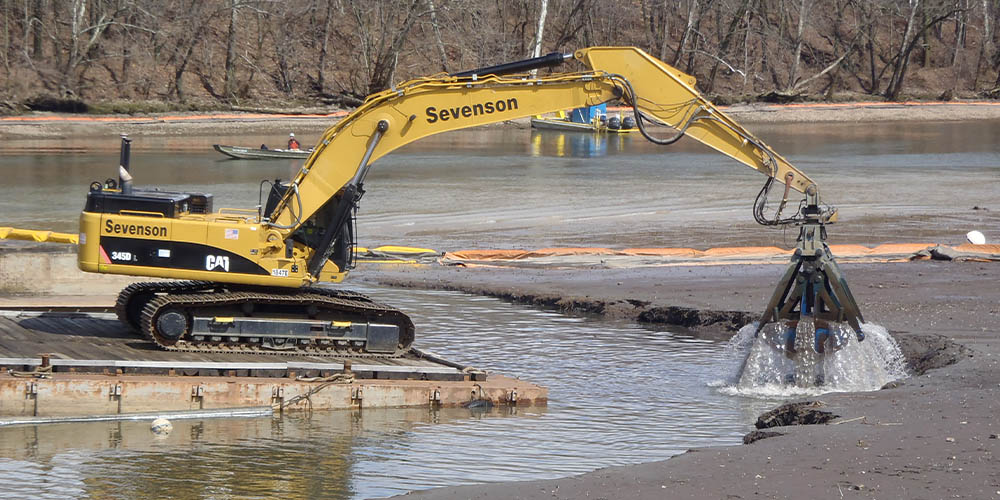
Roebling Steel Company Superfund Site
| Location | Roebling, New Jersey |
| Contract Value | Cost Reimbursable |
| Period of Performance | July 2009 – June 2014 |
| Role | Prime Contractor |
Significant Project Features
- Mechanical dredging and dewatering of 240,000 CY of sediments from Crafts Creek and Back Creek Channel
- Remediation was executed on a phased approach to comply with time constraints established by the client due to fish passage window
- Construction of dewatering areas for dredged sediments
- Transfer dredged sediments via sealed trucks to onsite storage located at former plant slag area
- Placement of a sand cap in dredge areas of Crafts Creek
- Wetlands restoration and rip rap placement
Project Gallery
History & Location Details
The Roebling Steel Superfund Site is a 200-acre inactive industrial complex located in the Village of Roebling, Florence Township, New Jersey. The Delaware River and Crafts Creek border the site on the north and east. Conrail railroad tracks run adjacent to the southern boundary. Residential properties are adjacent to the site which was constructed by the company to house employees. The closest residences are located about 100 ft from the site in addition to two (2) public playgrounds. Wetlands and forest areas comprise the remaining site property which slopes to the Delaware River bank and the former plant slag pile area.
Between 1906 and 1982 Roebling Steel produced steel products. Steel production generated significant quantities of liquid and solid waste materials. Most liquid waste was discharged into Crafts Creek and the Delaware River. Slag, mill scale, spent refractory materials and other production residues were disposed of on the plant property. In 1982, the site was added to the U.S. Environmental Protection Agency’s (EPA), National Priorities List (NPL). A RIFS was conducted in 1985. The RIFS identified numerous contamination sources and exposure pathways. The EPA delivered a phased approach to implementing remediation limiting the construction season to August 1st through December 14th. Due to these constraints, the project could not be completed in one (1) continuous season and required demobilization at each season’s end.
Project Description
The scope of work required Sevenson to mechanically dredge sediments from Crafts Creek and Back Creek Channel; dewater the sediment; transfer dewatered sediment to the former slag area for onsite storage; install a sand cap; and restore disturbed areas. Prior to initiating dredging operations Sevenson delineated work zones and established a perimeter air monitoring system. Support and access areas were identified as well as installation of temporary fencing and utilities; construction of equipment and material staging areas; erosion and sediment control measures; bathymetric and topographic site surveys; traffic control measures; WWTP; and, construction of dewatering areas for dredged sediments from Back Creek Channel and Crafts Creek. Sediments were mechanically dredged using a 1.5 CY environmental bucket mounted on a CAT 345 excavator and staged on dewatering pad then transported to Slag Area OU3 for onsite storage. Wetlands disturbed by remedial activities were restored.
- DEBRIS REMOVAL
The project included large scale debris removal along the entire shoreline, which was necessary for preparation of the slope for revetment installation. Approximately 265 tons of timber debris was removed and disposed of at a Sub-Title D disposal facility. The large concrete debris was sized and re-used on-site for backfill materials. The large slag debris was buried in other areas on-site. - DREDGING
Both Crafts Creek and the Back Channel are tidal waters with an average tidal fluctuation of six feet. Sevenson removed approximately 78,000 CY of heavy metal contaminated sediments from Crafts Creek and 164,000 CY from the Back Channel. Sevenson developed the dredging design surface to mirror the bottom of contamination. We used Dredgepack GPS-based software on all excavator dredges to increase the efficiency of sediment removal by minimizing over-depth dredging. This software allowed tolerances of +/- 2.4 inches to be achieved during dredging. - SEDIMENT DEWATERING
Dredged sediments were transferred to, and initially staged on, an asphalt dewatering pad for initial drying, and then transported via sealed trucks or off-road dumps for further dewatering and onsite storage. Sevenson enhanced our operations by constructing multiple holding areas (DMMAs) from on-site slag materials. The holding areas were strategically positioned within the OU3 Final Sediment Placement Area (SPA) to allow for high capacity storage of dredged materials from the loaded scows and the dewatering pad, which allowed for the gravity dewatering of the sediments. Sediments were periodically transferred from one area to the next to accelerate drying and dewatering before they were windrowed and placed/graded into the designated disposal area. This innovative approach resulted in accelerating final sediment placement 2½ months ahead of schedule - SITE/SHORELINE RESTORATION
Wetlands restoration included the replacement of over 47,000 native plant specimens at specified planting densities over ~715,000 SF of wetland areas that were disturbed during the dredging operations. A Professional Wetlands Scientist was used for the development of a Wetlands Restoration and Monitoring Plan and for supervision/general guidance during the restoration process. Due to tidal influence of the Delaware River into Crafts Creek and the Back Channel, planting was performed primarily during periods of low tide. Uplands restoration included replacement of native plant/tree/shrub species at specified planting densities over all areas disturbed during the support of the dredging and backfill operations. Sevenson obtained all specified plant/tree/shrub species from local nurseries and required them to be inspected and certified prior to delivery. All completed wetlands restoration areas underwent a three-phase inspection process that showed successful re-establishment of plants and habitat in all of the restored areas.
Rooted in Remedial Construction
Expanded into Environmental Dredging
Start a conversation about your upcoming project
(716) 284 - 0431
© 2021 Sevenson Environmental Services -
Privacy Policy | Sitemap
2749 Lockport Road | Niagara Falls, NY 14305
P: (716) 284 - 0431 | F: (716) 284 - 7645
